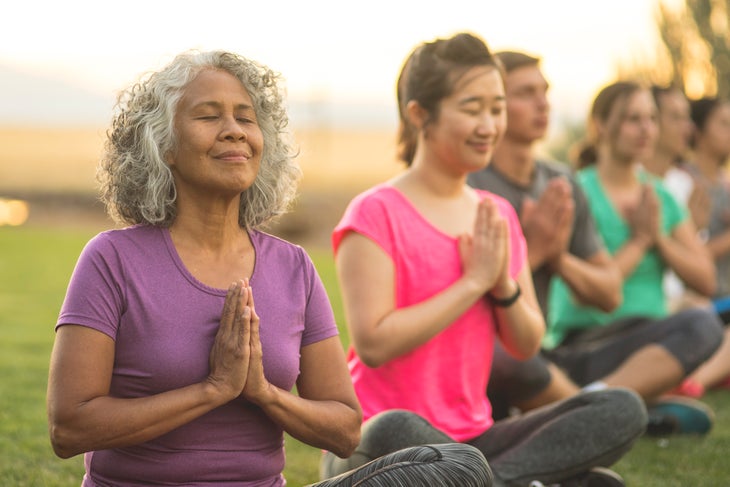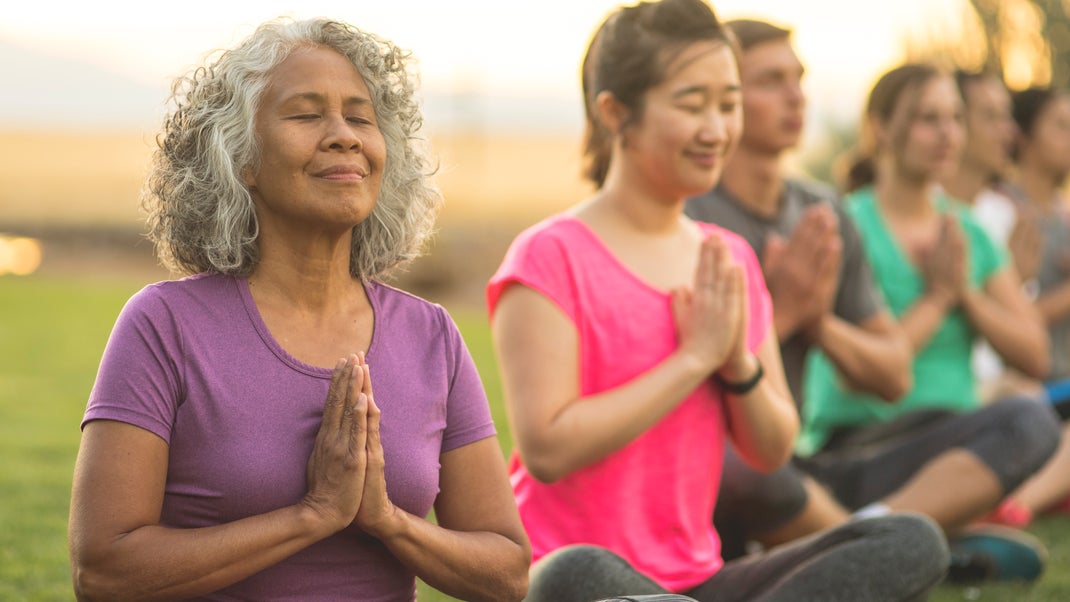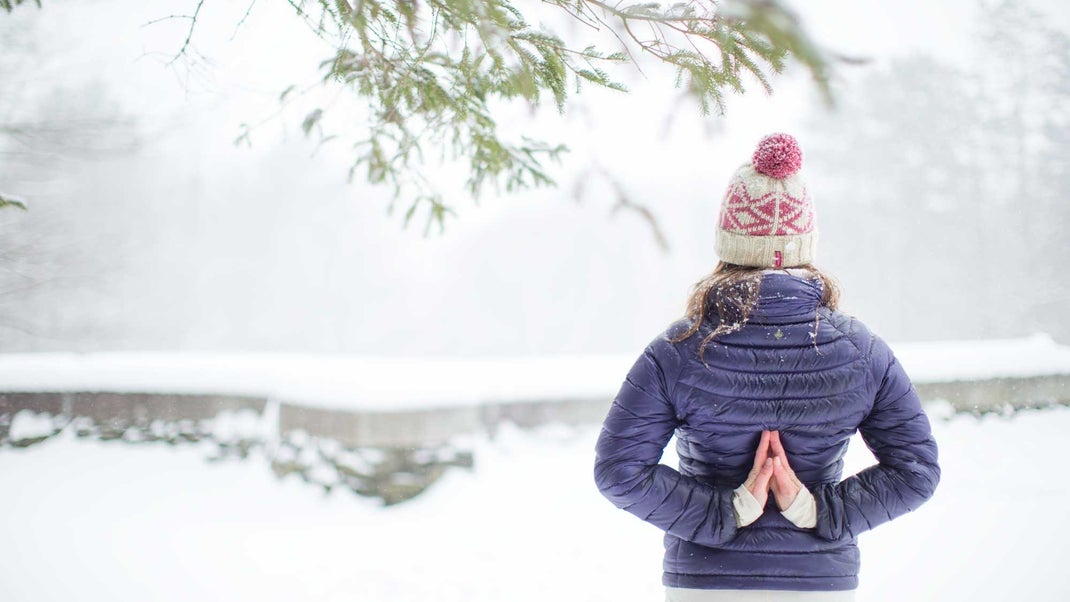For many, yoga is a way of life. It’s what they do to get their body back in shape after the stresses of work and family. When you start practicing at 29 years old, it might seem like your body will always be able to handle it. But time has a funny way of catching up with us all!
When you get past 50 or 60 years old, there are some changes that happen naturally in our bodies which make doing certain poses more difficult than when we were younger. This blog post will give you some advice on how to continue your practice without feeling too frustrated by these changes!
In our new advice column, Wolf Terry, a Bhakti Yoga teacher, and writer in Denver, Colorado, answers your pressing questions about practicing asana, meditation, mantra, and more. In this post, she covers senior yoga, how to stay active as you age, and how to injury-proof your practice,
 Dear Wolf, are there specialized precautions for people over 65? I don’t want to do chair or sedentary yoga. It seems to me that yoga classes are geared toward the younger crowd. I can pretty much keep up with the class, but I end up feeling quite sore (sometimes it’s painful). What should I avoid? What should I look for short of doing a senior class? I have asked a few teachers but they all say “do what your body can do.”
Dear Wolf, are there specialized precautions for people over 65? I don’t want to do chair or sedentary yoga. It seems to me that yoga classes are geared toward the younger crowd. I can pretty much keep up with the class, but I end up feeling quite sore (sometimes it’s painful). What should I avoid? What should I look for short of doing a senior class? I have asked a few teachers but they all say “do what your body can do.”
Sincerely, Over 70
Dear Over 70, this practice is for everybody. No matter how old we are, some days we may benefit from sitting and breathing more than moving and sweating. When teachers tailor their classes to a specific “set,” they miss opportunities to strengthen their teaching skills and cheer on and empower a diverse group of students. Please go find a teacher who is excited to help you with your practice, preferably someone who is an alignment nerd. Ask how much they charge for a private class or even just share with them what you’ve shared with me—chances are they’d love to walk you through anything you’re struggling with, free of charge. Keep up your practice. If you don’t have many options near you and you can’t find a teacher who fits your needs, do not let that deter you. Classes of all levels can be found online and at community gyms.
When you’re in class, if you’re comfortable being touched, ask for adjustments—a good teacher will be able to cue others while safely providing hands-on assists tailored to your body. Otherwise, most seasoned teachers will happily cue the whole class to fit your needs without making you feel singled out. If none of that works for you, cultivate your home practice. There are so many incredible resources at your fingertips (apps, the internet, and this YJ issue, for instance!).
Your soreness could be due to lactic acid buildup in your muscles or a lack of synovial fluid in your joints. Both of these are huge contributors to achy muscles and tight fascia. For alleviation, keep moving. To counter lactic acid, stretch mindfully. Go see your doctor if the pain continues or gets worse.
Lastly, the only thing you should avoid doing is giving up on your practice. Yoga in a chair is not the only type of yoga available to people over 70. Stay determined, stay hopeful, and keep asking the hard questions.
Dear Wolf, as a yoga practitioner of more than 15 years, I’ve noticed that as I get older and my body changes, my yoga also changes. I want to be one of those yogis who is still going strong at age 90! What sort of practice should I be doing now to try and achieve this goal? I also wanted to be one of those skiers who got a free ski pass when I turned 70 (yes, that used to be a thing in Colorado) but my knees don’t agree. What’s the best way to keep my practice changing with the passing years?
Sincerely, Not Old but Not 29 Anymore
Dear Not Old but Not 29 Anymore,
When I was in high school, our dryland trainer for Alpine ski racing was a 70-year-old Olympic gold medalist named Richard Taylor. He was a Nordic racing skier, which is different from Alpine—speed relies on endurance instead of gravity. Mr. Taylor roller skied around the whole town every morning before training as a warm-up. That was 15 years ago, and as far as I know, he hasn’t stopped.
Here’s what I learned early on, just from watching his commitment to his practice: If you continue to show up, your practice will, too. It doesn’t matter how you do it, it just matters that you do. What I’m saying probably sounds like a cop-out, but trust me; your practice is going to change and morph into something different than you ever imagined—yoga does that.
This is the practice that keeps all other practices going, after all. Breathe and move and keep living in the present—the past and the future are both irrelevant when it comes to yoga. Fifteen years is a long time, but you have a lot longer to go.
Dear Wolf, I’m 16 and I’ve been trying to find a way to get into yoga. I am going through such a rocky time in my life, and I need something to help me stay grounded and flow all of this negative energy out of my body. Any advice is really appreciated.
Signed, Rough Patch
Dear Rough Patch, sixteen is a tricky age. You aren’t quite an adult, but you’re definitely not a kid either. You’re just testing the waters of everything life has to offer—relationships, responsibility, freedom. Sixteen was not an easy age for me. Coincidentally, it was the year that I started my relationship with yoga.
I realized right away that I had intuitively been practicing it for a very long time without knowing it. I was breathing—that was it. Whenever I was moving through something particularly difficult I would take a deep, slow inhalation and count to four, then hold my breath for four counts, exhale to the count of four, and then pause for another four counts.
I did this intuitively, so it was surprising to learn that this was actually a type of yogic breathwork (pranayama) called samavrtti (equal breath). Yoga is a system consisting of eight limbs, and pranayama is the fourth. Asana—the third limb—is the one with all of the poses and arm balances, and while it has so many incredible benefits, I have always found pranayama more accessible and useful during my own rough patches. A good way to start incorporating yoga into your daily life is to take five minutes to focus on your breath. (Both asana and pranayama are centered around the breath.)
Breath is our life force. It allows us to release built-up tension, stale energy, and old patterns in order to bring in a clearer, more focused perspective. It reminds us that change is constant, that the ebb and flow of life is full of temporary moments. This rocky patch in your life is just that: temporary. Keep breathing. Things may not get easier immediately—or at all. I cannot promise you that yoga will solve all of your problems, but it’s there to meet you when and where you need it—and that, my friend, is something.
Conclusion:
When I was in high school, our dryland trainer for Alpine ski racing was a 70-year-old Olympic gold medalist named Richard Taylor. He was a Nordic racing skier, which is different from Alpine—speed relies on endurance instead of gravity. Mr. Taylor roller skied around the whole town every morning before training as a warm-up.
That was 15 years ago, and as far as I know, he hasn’t stopped. Here’s what I learned early on, just from watching his commitment to his practice: If you continue to show up, your practice will too.
It doesn’t matter how you do it, it just matters that you do. What I’m saying is probably like a cop-out, but trust me; your practice is going to change and morph into something different than you ever imagined – yoga does that. This is the practice that keeps all other practices going, after all.




